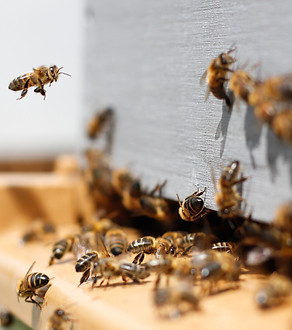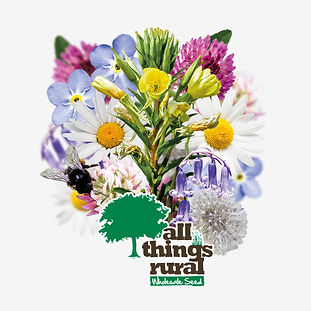
Pollinators and their Importance
When most people think of pollinators, bees often come to mind, but they include a wide variety of species like butterflies, moths, and hoverflies. These insects are critical to ecosystems, aiding in the reproduction of many plants and ensuring food production.
Gardens and wildflower meadows are vital habitats for pollinators in the UK. They provide essential food sources and shelter, making them crucial for supporting the declining populations of bees and other pollinating insects. Protecting these spaces has never been more critical to preserving biodiversity and sustaining ecosystems.

Bees are essential not only for honey but also for pollinating crops crucial to our food supply. Without them, farmers would need to take on pollination, costing the UK up to £1.8 billion annually and driving up food prices significantly. Protecting bees is vital for sustainable farming and affordable food.
Bees

Many of the UK's cherished bee species are in alarming decline, with 13 species lost to extinction since 1900 and up to 35 more at risk today. Habitat loss, changes in farming practices, pesticide use, climate change, and invasive species have all contributed to this worrying trend. Some pesticides, while protecting crops, are believed to harm bee populations. Globally, there are around 20,000 species of bees, with about 270 species found in Britain—underscoring the critical need to safeguard these essential pollinators for both biodiversity and food security.
Bees are in decline…

Pollinators play a crucial role in plant reproduction by transferring pollen from the male part of the flower (the stamen) to the female part (the stigma). This process allows the pollen to travel down the stigma to fertilise the ovules, enabling the plant to produce seeds and fruit. Without this essential step, many plants would be unable to reproduce.
While some plants can self-pollinate, most rely on cross-pollination, where pollinators like bees, butterflies, and other species transfer pollen between flowers. This interaction is vital for the biodiversity of ecosystems and the production of many crops.
Pollinators
Bee Species Examples:
-
There are over 300 species of bee in the UK.
-
Is a social bee that forms large colonies overwinter.
-
Colony may contain 60,000 bees.
Honeybee

-
There are 260 species including: Andrena, Osmia, Megachile and Lasioglossum.
-
Females of solitary bees constructs and provisions a nest on their own.
-
Will often nest close to one another.
Solitary Bee

-
Is a social bee.
-
Nests die out in late summer or early autumn.
-
There are 24 species of bumblebees in Britain but only 12 species are commonly seen in gardens.
-
A nest may contain 200 bees.
Bumblebee


Spring
Apple blossom is loved by bees and with dwarf fruit trees now available that can be grown in pots, they can be enjoyed by you and and the bees, whatever your size of garden. Bees also love bluebells and crocuses! When out walking, look out for the emergence of the beautiful cowslip which is loved especially by the Garden Bumblebee and the Hairy Footed Flower Bee!

Summer
Lavender is loved by bees, especially Bumblebees, Leafcutter Bees and Mason Bees. When lavender is in flower in summer, it is a ‘hive’ (pardon the pun!) of activity for hungry bees! When out walking, look out for a vibrant wildflower that is a favourite for bees…Phacelia. Not only are the sweetly scented purple blooms extremely attractive to bees, this species is also known as a green manure, which boosts soil fertility.

Autumn
The sweetly scented honeysuckle is a climber so is great for training up walls if space is a problem. It is loved by bees, especially the Carder Bumblebee and is also a enjoyed by many moth species late evening. When out walking, look out for white clover which is still showing its pretty white to pinkish flower heads into October. These are loved by many kinds of bumblebees.

Winter
Snowdrops are pollen rich and are a perfect food source for bumblebees and honeybees. When out walking, look out for Lesser Celandine, which flowers from January until April and supplies an essential nectar source for bumblebees and other pollinators coming out of hibernation.
Hoverflies are vital garden pollinators that are often mistaken for bees or wasps because of their similar appearance, although they are actually flies. These harmless insects do not sting, making them a safe alternative to their more aggressive look-alikes. This phenomenon is known as Batesian Mimicry, where a non-harmful species mimics the appearance of a dangerous one to avoid predators. Hoverflies, also known as Syrphid flies, Flower flies, or Drone flies, are commonly found in gardens during the spring, summer, and autumn months, where they feed on nectar and pollen. Their larvae, which are effective predators of aphids and other pests, add extra value by helping control harmful garden insects.
Hoverflies vary in size, ranging from 10 to 25mm, and there are about 250 species in the UK. Some flowers that attract hoverflies include Oriental Poppies, French Marigolds, Wild Carrot, Knapweed, Marsh Marigold and Fennel. .
Bees or Hoverflies?


Butterflies are the second-largest group of pollinators after bees. In Britain, there are 59 species, each with unique preferences for plants during their larval and adult stages. As adults, they feed on flower nectar, transferring pollen and helping with pollination.
Butterflies
The increasing popularity in wildflowers is great news for our pollinators!
Wildflowers offer a stunning display in gardens, the countryside, or even as a feature on eco homes' green roofs. Their growing popularity is thanks to increased awareness about climate change, the decline of pollinators, and their natural beauty. Wildflowers are crucial for supporting bees and other pollinators, providing habitat and food with minimal effort. We offer a variety of wildflower mixtures tailored to attract a wide range of pollinators, including bees, butterflies, and hoverflies, helping to boost biodiversity and create vibrant, eco-friendly spaces.
Bees and other pollinators don’t just love wildflowers, they love grasses too.
We offer a great grass mix for them too.
Bee Grass Mix
70% Cocksfoot
30% Meadow Foxtail
Both Cocksfoot and Meadow Foxtail are excellent grass species for supporting a wide range of pollinators and wildlife. Cocksfoot is particularly beneficial for bees, especially honeybees, due to its pollen-rich flowers, and provides valuable cover for ground-nesting solitary and mining bees. The dense growth habit and deeper root system also make it drought-tolerant once established. Cocksfoot is also a food source for caterpillars, including those of the Meadow Brown and Gatekeeper butterflies, while its seeds are enjoyed by finches and game birds.
Meadow Foxtail, on the other hand, is particularly important for caterpillars, including those of the Essex Skipper butterfly, making it a crucial food source in the ecosystem. This mix, which doesn’t rely on wildflowers, offers fantastic benefits for pollinators and wildlife, creating a rich habitat for a variety of species.










